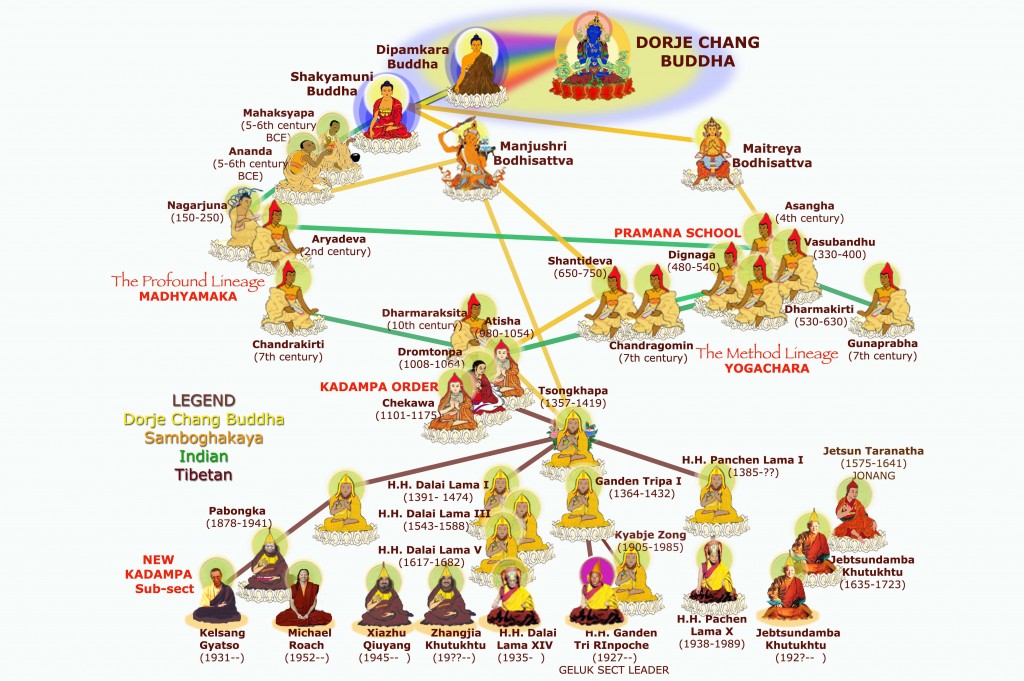 Founded in Tibet by the Indian Dharma King Atisha in the 11th century based on oral teachings derived from the transmitted teachings of the Buddha. Dharma King Atisha (982-1054) integrated the two mahayana lineages of Nagarjuna (The Profound Lineage) and Asanga (The Method Lineage). Atisha was also influenced by the writings of Shantideva (650-750). He established the Lam Rim system for teaching in the Lamp for the Path to Enlightenment. This book became the foundation for the other Tibetan schools, especially the Gelugpa. Although the Kadampa School ceased to exist as an independent school in Tibet, its doctrines were integrated into the other sects and it became the Geluk Sect. It serves as the basis for the New Kadampa Tradition that was founded in Britain by Geshe Kelsang Gyatso (1931- ) who has established many dharma centers in the West. The New Kadampas allege that the present Geluk school and specifically the current Dalai Lama have departed from the teachings of the founders of this movement.
Founded in Tibet by the Indian Dharma King Atisha in the 11th century based on oral teachings derived from the transmitted teachings of the Buddha. Dharma King Atisha (982-1054) integrated the two mahayana lineages of Nagarjuna (The Profound Lineage) and Asanga (The Method Lineage). Atisha was also influenced by the writings of Shantideva (650-750). He established the Lam Rim system for teaching in the Lamp for the Path to Enlightenment. This book became the foundation for the other Tibetan schools, especially the Gelugpa. Although the Kadampa School ceased to exist as an independent school in Tibet, its doctrines were integrated into the other sects and it became the Geluk Sect. It serves as the basis for the New Kadampa Tradition that was founded in Britain by Geshe Kelsang Gyatso (1931- ) who has established many dharma centers in the West. The New Kadampas allege that the present Geluk school and specifically the current Dalai Lama have departed from the teachings of the founders of this movement.
The Geluk school was founded in the 16th century in Tibet. This school is the outcome of the efforts of Dharma King Tsongkhapa (1357-1419) to reform the monasteries and reestablish the true Buddha-dharma. It grew out of the Kadampa sect, but also included some teachings of other sects as well. In later years it became the most politically active of the four major sects with its secular head, the Dalai Lama, being also the secular leader of Tibet since the 17th century. Its monks are celibate and subject to strict disciplinary rules. After the death of the Jonang leader, Tarantha, in 1641, the Great Fifth Dalai Lama consolidated the Jonang temples into the Geluk system and outlawed the teaching of Jonang texts. Tarantha reincarnated as the first Jetsundhampa Khutukhutu (1635-1723) in Outer Mongolia. The current Dalai Lama has stated that this was politically motivated and reinstated the Jonang Sect.
The Geluk School was the largest of the four Tibetan schools with many western followers. Many of the Geluk groups in America originated with the Dalai Lama’s main temple at Drepung Loseling in Southern India or with Lama Zopa’s Foundation for the Preservation of the Mahayana Tradition (FPMT). The spiritual head of the Geluk sect is known as the Ganden Tripa or holder of the throne of Ganden, the main monastery of Tsongkhapa. Tsongkhapa was the first Ganden Tripa. This position is considered higher than either the Panchen Lama or the Dalai Lama, both of whom have to bow when they meet the Ganden Tripa. The Ganden Tripa is elected by the Geluks as the one who holds the highest realization within the Geluk, a position that is normally held for seven years.
